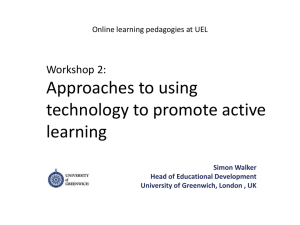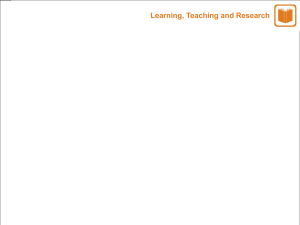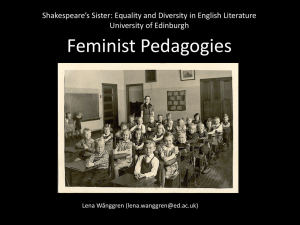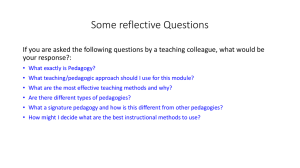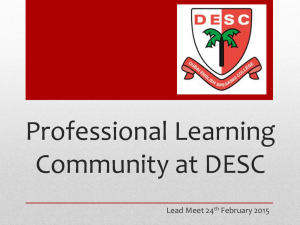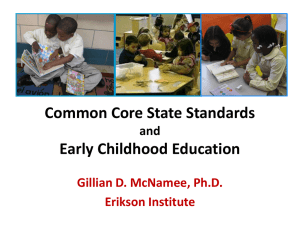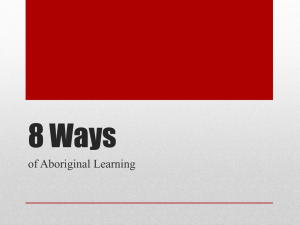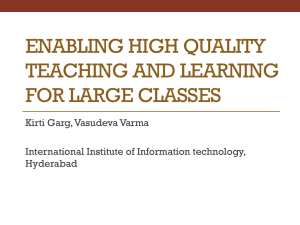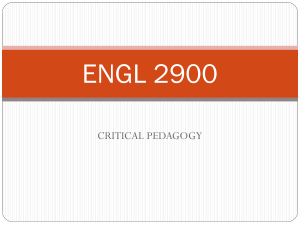Queensland experience: connecting curriculum-pedagogy
advertisement
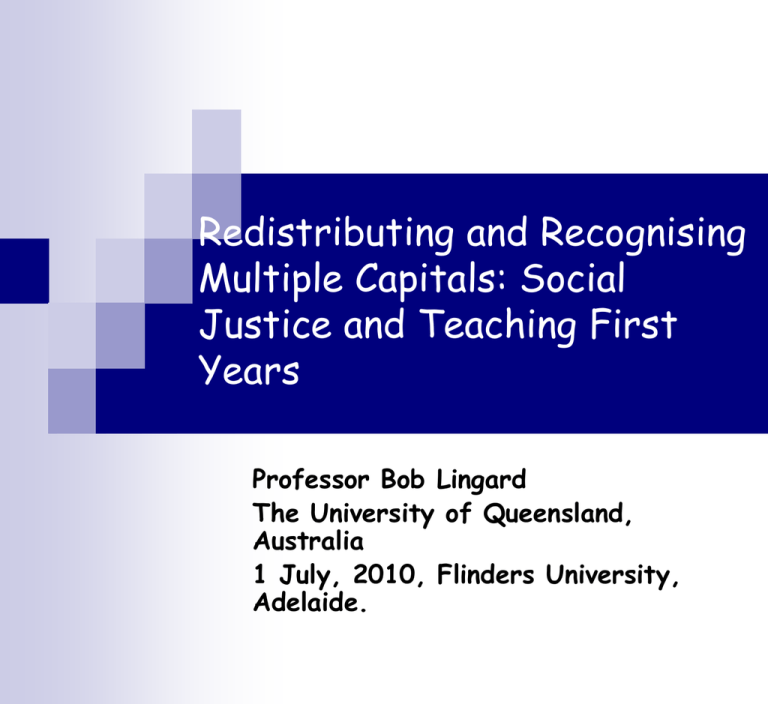
Redistributing and Recognising Multiple Capitals: Social Justice and Teaching First Years Professor Bob Lingard The University of Queensland, Australia 1 July, 2010, Flinders University, Adelaide. Structure of Address Defining Social/Equity Justice in Higher Education. Nancy Fraser: politics of recognition and politics of redistribution. Bourdieu and multiple capitals argument. Higher Education Policy Context. Higher Education Equity Policy Context. Issue of Schools in Low SES Communities and School Performance. Premises of Argument. Overarching Premise. Queensland School Reform Longitudinal Study: productive pedagogies. Alignment: Curriculum, Pedagogy and assessment. Whose Knowledges? Epistemologies/Ontologies. Relevance to university context. Conclusion. Social Justice and Equity In policy terms still defined by 1990 statement: A Fair Chance for All. Proportional representation definition – concern with point of university entry. High SES b/grd students 3 times more likely to enter university than those from low SES b/grds. Indigenous students 2.2% of population and 1.3 % of all university students. Low SES 15% for 20 yrs. 25% of population regional and remote, only 18% of university students from these bgrds. 8% with disability, only 4% of university students. Current policy framed by proportional representation argument. Need a bigger narrative: a new ‘social imaginary’ of social justice End of history (Fukuyama), Post-Socialist condition(Fraser), end of meta-narratives (Lyotard). Globalisation and impact on SES/social class. Scholte (2000, p.260): ‘stratified access to global space’; hyper-mobility and immobility. Access to, performance in and outcomes from. Framed by considerations of justice/social justice (cf equity). Vince Tinto (2008): ‘access without support is not opportunity’; Trevor Gale (2010, p.9): ‘opportunity confined to support is not equity’. Challenges to what a higher education means: redistributing of capitals and recognising other capitals. Pedagogy, curriculum and assessment. Social Justice, Barack Obama and Martin Luther King I know you are asking today, ‘How long will it take?’...I come to say to you this afternoon, however difficult the moment, however frustrating the hour, it will not be long because truth pressed to the earth will rise again. How long? Not long, because no lie can live forever. How long? Not long, because you shall reap what you sow... How long? Not long, because the arc of the moral universe is long but it bends toward justice. (Martin Luther king, 26 March, 1965) Need a narrative and politics of hope. Nancy Fraser (1997) Social Justice and a Politics of Redistribution and a Politics of Recognition Rejects an ‘end of history’ thesis: but suggest in our ‘post-socialist’ condition the grammar of political claim making has changed (USA focus). Here she speaks of politics of ‘recognition’: the rise of identity politics and decentering of class and the prioritising of a recognition politics around identity and difference. Related to a decoupling of this cultural politics of recognition from a social politics of redistribution. Decentring of claims for equality in face of neo-liberal marketisation and sharply rising inequality. Rose (1999) ‘self-capitalising’ individual. Need for both politics: affirmation to transformation. Bourdieu,multiple capitals and the (re)production of inequalities. A sociological account: Bourdieu – habitus, capital, fields, practice. Habitus: a socially, culturally, historically embodied ‘system of dispositions’ (classed and gendered); possession and relationship to different capitals. Fields: the social consists of multiple fields: a specific field provides a magnetic attraction for agents disposed to engage in a given field because of the alignment of their habitus with the field. Capitals: cultural capital – disposition towards high status cultures and knowledges; social capital – networks; all linked to economic capital; multiple capitals involved in construction of social class. ‘Praxaeological knowledge’: statistical probability and dispositions to act. Bourdieu and the (re)production and legitimation of inequality ‘In fact to favour the most favoured and disfavour the most disfavoured, all that is necessary and sufficient is for the school to ignore in the content and teaching it transmits, in the methods and techniques of transmission and the criteria for judgement it deploys, the cultural inequalities that divide children from different social classes. In other words, by treating all students, however much they differ, as equal in rights and duties, the educational system actually gives its sanction to the initial inequality in relation to culture’. (Bourdieu, 2008, p.36) This cultural reproduction ‘misrecognised’ as related to differences in individual capacities; a ‘social gift treated as a natural one’ (Bourdieu, 1976, p.110). Need to recognise difference capitals and scaffold to and be explicit about all requirements across the three message systems of curriculum, pedagogy and assessment. Bourdieu and explicitness of pedagogies for interrupting reproduction ‘If all pupils were given the technology of intellectual inquiry, and if in general they were given rational ways of working (such as the art of choosing between compulsory tasks and of spreading them over time), then an important way of reducing inequalities based on cultural inheritance would have been achieved’. (Bourdieu, 1990, p.309) ‘Absolutely necessary to give priority to those areas where the objective is to ensure that fundamental processes are thoughtfully and critically assimilated. These processes – the deductive, the experimental, the historical as well as the critical and reflective – should always be included’. (Bourdieu, 1990, p.309). Need for a ‘rational pedagogy’ that ‘seeks to neutralise the effects of social factors of cultural inequality’. (Bourdieu, 1979, p.76) Bourdieu and neo-liberal globalisation Bourdieu (1998) suggests in this context workers in the ‘left hand’ of the state have to bear the fall-out from neoliberal policies framed by what he calls the ‘right-hand’ of the state. Thus teachers are almost forced to take on a social worker role. This most often results in a trade-off between an almost therapeutic culture of care within classrooms (particularly in schools in poor and working class communities) and intellectual demand, to the academic disadvantage of the disadvantaged. Capitals and the codes of schooling/university ‘Intellectual rigour’ and ‘relevance’ as equity strategies. Schools and universities: Brennan and Zipin (2005) two strategies re disadvantaged students: ‘give them the codes’ vs ‘stuff the codes: give them intelligent relevance’. Access to the codes: redistribute the required capitals, but also recognise different capitals. Bernstein (1990) makes a distinction between vertical and horizontal discourses. Carolyn Williams and Steve Evans (2010) ‘Pedagogies for Social Justice: Did Bernstein get it wrong?’ International Journal of Inclusive Education, 14 (4), pp.417-434. Teaching FYHE, Social Justice and the HE Policy Context Higher education policy aspiration: 2020, 20% of all u/g students in unis from low SES (cf 15% constant figure across recent past). Necessary to meet 2025 target of 40% of 25-34 years olds with a Bachelors degree. Relationship between student demand and supply will change with student demand being at a constant level over last decade and will trend down if economy does well again (counter cyclical nature of student demand). ‘Expanding the higher education system and diversifying its student population will need to be done in the context of insufficient student demand’ (Gale (2010, p.1). Gale (2010) argues in this context student aspiration will become more important than student achievement for achieving Bradley and government targets, but aspirations less amenable to policy interventions. Relationship between achievement and aspiration. Re-differentiation, re-hierarchisation of universities; Go8 ‘downsize’ u/g intake? First Year Students and the Equity Agenda Federal government target: 90% retention to Yr 12 or equivalent by 2015. Rise in VET participation by 15-19 yr olds. Only 20% of VET students are enrolled in courses (Cert 4 and Diploma and above) that articulate clearly with university. In terms of equity: participation rates in these VET courses which articulate with university reflect University student SES profile. Queensland figures next slide as an example of the issue; enhanced Yr 12 retention not enhanced numbers of ‘traditional candidates’: the biggest equity issue? ‘To achieve the sector targets, Australian universities will need to find ways in which to work collaboratively to address the more basic problem of insufficient supply of qualified applicants’. (Gale, 2010, p.8); issues of achievement in many low SES schools. Queensland example: expanded provision of senior schooling and retention to Yr 12 Year Cohort OP eligible % OP ineligible % 2000 38211 27839 73 10372 27 2002 38820 27749 71 11071 29 2004 38451 27235 71 11216 29 2006 39579 26233 66 13346 34 2009 43191 25305 59 17886 41 Trend Data: OP eligible and OP ineligible students, 2000-2009 Context: Issue of SES and School Performance Low SES and retention, subject and course choice in Yrs 11 & 12, performance. Relationship between Gini Coefficient of Inequality and strength of correlations between social class background and school performance. An issues in context of neoliberal policy contexts. Redistribution: National Partnership Low SES Schools: accountability tied tightly to NAPLAN results: thus won’t distribute the necessary capitals. Premises of Argument 1 Nature of pedagogies: a social justice issue: Skills of ‘deep learning’ (not ‘surface learning’), ‘criticality’ etc are central to emancipatory/socially just higher education (Hockings, Cooke and Bowl, 2010, p.96). Limited research re changed higher education populations and required pedagogies. Recognise work of Sally Kift, Keitha Wilson, Karen Nelson etc. Lessons to be learnt from school pedagogies research. Effects of social class or socio-economic background on student performance at school; Gini Coefficients of Inequality; relationship between amount of social inequality in a society and strength of correlations between social class background and school performance. ‘…the TER is an authoritative measure that rewards the cultural resources characteristic of the most economically powerful groups in society’ (George et al., 2005, p.144). ‘In other words, the ENTER (or TER or OP or UAI) is more indicative of socioeconomic status than it is of a student’s academic potential’ (Gale 2009, p.7). Premises of Argument 2 School factors: teachers’ pedagogies most significant (see Hattie, 2009) cf university?. School factors: Townsend (2001, p.119): 5-10 % of variance in student performance to do with school and 35-55 % of variance due to teacher effects. Pedagogies can make a difference, but not all the difference re student capitals and social class backgrounds. Effects of social class or socio-economic background on student performance at school; ‘Economic capital’ and valued ‘cultural capital’ relationships (Bourdieu); recognition and redistribution. Need for alignment of the message systems of educational institutions: curriculum, pedagogy and assessment. Overarching Premise Set against a definition of Equity and Social Justice as needing to take into account: access to, performance in and outcomes from university. To adequately meet government’s equity targets: serious thought will need to be given to the equity and social justice aspects of university pedagogies, especially in first year, but not exclusively there. Recognise that once low SES students and others get in to university their performance and retention no different from total student population, but to meet targets, students without traditional forms of preparation will get to university (aspiration agenda). In this context: issues of curriculum, pedagogy and assessment will become of paramount importance. Curriculum issue probably links to epistemology and ontology: Trevor Gale’s (2009) Keynote: ‘Towards a Southern Theory of Higher Education’. The Queensland School Reform Longitudinal Study (QSRLS) Developed concepts of productive pedagogies, productive assessment and productive leadership. Sociological approach to pedagogy Jennifer Gore (1993): The Struggle for Pedagogies: binary of pedagogical research vision vs explicit instructional focus. Critical pedagogy tradition: Paulo Freire (1973) Pedagogy of the Oppressed. Feminist pedagogies; empirical, Fred Newmann and Associates (1996). Need a more empirically grounded approach to pedagogies, but with political aspirations of critical pedagogy. Renewed interest in pedagogies from a sociological perspective: evaluation message system become a major steering mechanism of schools. Robin Alexander’s (2000) Culture and Pedagogy and Bernstein’s (2004) work on pedagogy as ‘cultural relay’. Bernstein and Bourdieu: pedagogies and social and cultural reproduction. Definitions of pedagogy Alexander (2000, p.540): ‘Pedagogy connects the apparently self-contained act of teaching with culture, structure and mechanisms of social control’. Alexander (2000, p.3): pedagogy includes: ‘culture and classroom, policy and practice, teacher and learner, knowledge both public and personal’. Bernstein (2001): ‘totally pedagogised society’. References: school reform Fred M. Newmann and Associates (1996) Authentic Achievement: Restructuring Schools for Intellectual Quality, San Francisco, Jossey-Bass. Valerie E. Lee with Julia B. Smith (2001) Restructuring High Schools for Equity and Excellence What Works, New York, Teachers College Press QSRLS Backward mapping Student Outcomes Classroom Classroom Practices Practices School Organisational School Capacity Organisational Capacity External Supports External Supports Four Levels of School Restructuring (Queensland School Reform Longitudinal Study) Centrality of teachers Changing practice is primarily a problem of teacher learning, not a problem of organization… School structures can provide opportunities for the learning of new teaching practices and new strategies for student learning, but structures, by themselves do not cause learning to occur…School structure follows from good practice but not vice versa. (Elmore, Peterson and McCarthey, 1996, p.149) Main References from QSRLS Lingard, B., Hayes, D., Mills, M. and Christie, P. (2003) Leading Learning Making Hope Practical in Schools, Maidenhead, Open University Press. Hayes, D., Mills, M., Christie, P. and Lingard, B. (2006) Teachers & Schooling Making a Difference, Sydney, Allen & Unwin. References: Publications from the QSRLS Lingard, B., Hayes, D. and Mills, M. (2003) ‘Teachers and Productive Pedagogies: Contextualising, Conceptualising, Utilising’, Pedagogy, Culture and Society, Vol 11, No 2, pp.399-424. Lingard, B., Mills, M. and Hayes, D. (2000) ‘Teachers, School Reform and Social Justice’, The Australian Educational Researcher, Vol 27, No 3, pp.93-109. Lingard, B., Hayes, D. and Mills, M. (2002) ‘Developments in School-Based Management: The Specific Case of Queensland, Australia’, Journal of Educational Administration, Vol 40, No 1, pp.111-122. Lingard, B. and Christie, P. (2003) ‘Leading Theory: Bourdieu and the Field of educational leadership’, International Journal of Leadership in Education, Vol 6, No 4, pp. 317333. Other publications derived from QSRLS B.Lingard (2005) Socially Just Pedagogies in Changing Times, International Studies in Sociology of Education, 15 (2), pp.165186. B.Lingard, M.Mills and D. Hayes (2006) Enabling and aligning assessment for learning: some research and policy lessons from Queensland, International Studies in Sociology of Education, 16 (2), pp.83-103. B.Lingard and M.Mills (2007) Pedagogies making a difference: issues of social justice and inclusion, International Journal of Inclusive Education, 11 (3), pp.233-244. B.Lingard (2007) Pedagogies of indifference, International Journal of Inclusive Education, 11 (3), pp.245-266. Authentic Pedagogy Newmann’s research identified 4 elements of what was termed Authentic Pedagogy; Higher order thinking Depth of knowledge and understanding Substantive conversation Connectedness to the world beyond the classroom. QSRLS Productive Pedagogies represent a refinement and expansion of these elements to a 20 item instrument consisting of 5 point scales, which measure performance on 4 domains The twenty elements of productive pedagogies Problematic knowledge Higher-order knowledge Depth of knowledge Depth of student understanding Substantive conversation Metalanguage Connectedness to the world beyond the classroom Knowledge integration Background knowledge Problem-based curriculum Students’ direction Explicit quality performance criteria Social Support Academic engagement Student self-regulation Cultural knowledges Active citizenship Narrative Group identities in learning communities Representation Examples of elements of Productive Pedagogies Substantive conversation: Does classroom talk break out of the initiation/response/evaluation pattern and lead to sustained dialogue between students, and between teachers and students? Metalanguage: Are aspects of language, grammar and technical vocabulary being foregrounded? Higher-order thinking: Are higher-order thinking and critical analysis occurring? Queensland School Reform Longitudinal Study (QSRLS) Conducted by UQ for EQ – 1998 – 2000. Commissioned to study the impact of school-based management on student outcomes. Reconceptualised to ‘backward map’ from desired learning outcomes to classroom practices (pedagogies and assessment) (social as well as academic outcomes). Concern about alignment of the 3 message systems: curriculum, pedagogy, assessment. Focuses on classrooms 24 schools, purposive sample Teacher questionnaires 975 lessons mapped – Maths, Science, English, Social Studies Across years 6, 8 and 11, plus observed ‘outstanding teachers’ Lessons coded on 20 elements (of Productive Pedagogies) Productive pedagogies derived from ‘authentic pedagogy’ Assessment work collected as well (tasks and student work) Supportive school organisational capacity building: mobilising social capital. Dimensions of Productive Pedagogies Intellectual Quality Connectedness Supportive Environment Working with and valuing differences Higher order thinking Knowledge integration Student direction Cultural knowledges Deep knowledge Background knowledge Social support Inclusivity Deep understanding Problem-based curriculum Academic engagement Narrative Substantive Conversation Connectedness beyond classroom Explicit criteria Group identities Student selfregulation Active citizenship Problematic knowledge Metalanguage Supportiveness dimension Engagement: Are students engaged and ontask? Student self-regulation: Is the direction of student behaviour implicit and self-regulatory or explicit? Student direction of activities: Do students have any say in the pace, direction or outcomes of the lesson? Social support: Is the classroom a socially supportive and positive environment? Explicit criteria: Are the criteria for judging student performances made explicit? 1998 1999 2000 TOTAL (n=302) (n=343) (n=330) (n=975) Mean Std Mean Dev Intellectual Quality Connectedness Std Mean Dev Std Mean Dev Std Dev 2.16 .77 2.17 .73 2.47 .91 2.27 .82 1.84 .77 1.97 .79 2.39 .97 2.07 .88 2.75 .63 3.05 .67 3.26 .67 3.03 .69 1.79 .51 1.89 .50 2.13 .54 1.94 .54 Supportive Classroom Environment Working with and Valuing Difference Central findings re pedagogies in approx 1000 classrooms High levels of supportiveness: high mean and low standard deviation. Low levels of intellectual demand and connectedness: low mean and high standard deviation. Absence of working with and valuing difference: low mean and low standard deviation. Other Findings A lot of social support: social capital? Supportive pedagogies. Not enough intellectual demand, connectedness and working with difference: need for focus on other forms of capital in addition to social capital. Differences across curriculum areas. Differences across year levels. Teacher goals significant and perception of nature and location of teachers’ work. Equity considerations; pedagogy as a social justice issue. Too much curriculum content; less is more? Non-alignment of assessment practices (particularly in primary schools). Need for greater teacher assessment literacy, including consistency of teacher judgement; need for teacher networks within and across schools. School size effects: implications in terms of social capital. Primary and secondary differences. School leadership: learning communities and pedagogical focus. Need for teacher professional learning communities: significance of ‘we’. Relevance to university teaching? Table 1.12 Correlations between productive classroom practices and student outcomes aggregated to the school level Academic performance Overall intellectual quality Overall connectedness Overall supportive practices Overall recognition of difference * Social performance .59 ** .27 .40 * .53 ** .54 ** .37 * .15 .40 * Correlation is significant at the .05 level (2-tailed) ** Correlation is significant at the .01 level (2-tailed) Explanations of ‘Findings’ Extent of curriculum coverage. Curriculum pacing. Class size? Teacher threshold knowledges. Systemic reforms: testing and accountability, social justice ones?, definition of teacher work (care and support); trade-offs care/support and intellectual demand. Growing inequalities. Teachers with high ratings on the productive pedagogies measure differed significantly from those with low ratings particularly in terms of their: Sense of responsibility Efficacy in improving student learning outcomes Broad Conceptions of their role as teacher – in school, community and society, and Understanding of curriculum, pedagogy and assessment links and need for alignment Bourdieu and the findings of the productive pedagogies research The absence of intellectual demand particularly in schools serving disadvantaged communities has social justice implications. Indeed, this absence of intellectual demand works in ways which Bourdieu suggests schools reproduce inequality, that is, by demanding of all that which they do not give, those with the requisite cultural capital are advantaged through schooling. Also ‘decontextualised’ knowledge: knowledge not scaffolded and linked to students’ life worlds. Impact of NAPLAN. Differential impact across schools positioned differently in relation to NAPLAN and My School tables. Pedagogies are a social justice issue: need redistribution of capitals: ‘give them the code’: even more the case for universities. Fraser’s ‘recognition of difference’ Why so little? Context: ‘fear of difference’; lack of teacher PD cf Fraser’s politics of recognition. Appropriate unit of analysis? Counterintuitive finding: inverse relationship between ethnic diversity of school population and amount of working with and valuing difference. Indigenous school: ATSI Studies, Principal, Motto: ‘strong and smart’. Bernstein (1971) ‘Education cannot compensate for society’. BUT schools and teachers can make a difference. Pedagogies and assessment practices are central to teachers making a difference. Alignment issue: curriculum, pedagogy and assessment Productive pedagogies Productive pedagogies work with a redistributive as well as recognition politics and as such seek to maximise teacher effects in respect of both knowledge production and identity and disposition formation. Such pedagogies seek to broaden access to high status capitals, to in effect redistribute capitals and at the same time valorise other capitals as a way of working with and valuing difference. These are central to transformative, progressive pedagogies today in what Fraser (1997) calls our ‘postsocialist’ condition’. PPs and further research Productive pedagogies sit across critical pedagogy tradition (social justice focus) and more empiricist, instructional tradition (Newmann and Associates (1996) ‘authentic pedagogy’). ‘Productive pedagogies, politically aware and empirically based – working with both vision and instructional concerns – would appear to offer potential for future pedagogical research from a sociological perspective’. Research on university pedagogies and recontextualising the framework. What does the research tell us: context and school effects? Effects of social class or socio-economic background on student performance at school; Gini Coefficients of Inequality. ‘Economic capital’ and valued ‘cultural capital’ relationships (Bourdieu). School factors: teachers’ pedagogies most significant (see Hattie, 2009). School factors: Townsend (2001, p.119): 5-10 % of variance in student performance to do with school and 35-55 % of variance due to teacher effects. Teachers’ pedagogical practices central here: productive pedagogies four dimensions (intellectual quality, connectedness, supportiveness, working with and valuing differences) and alignment with curriculum goals and assessment practices, very important. Qualities of pedagogies a social justice issue, but also need to address issues of poverty: need to redistribute capitals (give them the code) and recognise multiple capitals; care and support – necessary but not sufficient. Queensland Longitudinal Study of Teaching and Learning (2007-2008) (Mills, Goos et al.) This project to focus on middle years: 4,6, 8, 9 trends in teaching practice associated with government initiatives 18 Case study schools lesson observations (English, Mathematics, Science, SOSE; Years 4, 6, 8, 9) (approx 400) analysis of assessment tasks, student responses, teacher judgments, interviews with teachers, students, school leaders, parents 150 Survey schools – teachers, parents and students Dimensions Correlation coefficients Intellectual quality 0.063 Connectedness 0.135** Supportive environment 0.138** Working with difference 0.006 Correlations between PP Dimensions and IRSED scores * Correlation is significant at the 0.01 level (2-tailed). Comparison of Means for Two Dimensions for All Schools, 2000 and 2008 (Productive Pedagogies) Intellectual demand Working with and valuing difference 2000 2.27 1.95 2008 2.47 2.10 QLSTL (2007-2008): Transition Problem in Pedagogies Yea r 4 Yea r 8 5 Yea r 6 Yea r 9 4.5 4 Mean Score 3.5 3 2.5 2 1.5 1 IntQual Connect Support Dimension Difference Transition problem? Cultural differences across institutions. Changes in students. Different pedagogical approaches. Assumptions about students. Transition to university issues – transition pedagoges. Alignment: Curriculum, Pedagogy and Assessment Central to socially just schooling. Assessment practices and pedagogies aligned in terms of dimensions and with higher order purposes of curriculum. Assessment: scaffolding, ‘give them the codes’, criteria sheets, examples of essay structures, good assignments etc. Central because this message system can steer the others (e.g, high stakes testing) Alignment and assessment need to be on the equity agenda. Curriculum: Knowledges Trevor Gale (2010): ‘Towards a Southern Theory of Higher Education’. (R. Connell (1993) ‘Northern Theory: The Poiltical Geography of General Social theory’, Theory and Society., 35 (2), pp.237-264. R.Connell (2007) Southern Theory, Sydney, Allen & Unwin. International Students: Appadurai (2000). Indigenous Students. Low SES Students. Rejection of ‘epistemological innocence’ (Bourdieu, 1999). Edward Said: displacement. Conclusion Need bigger narrative of hope, a new social imaginary of social justice and education in a globalised world. ‘…the arc of the moral universe is long but it bends toward justice’. Equity and expansion concerns if HE policy: more ‘non-traditional’ students will enter university. Support is necessary but so too is thought about pedagogies as a social justice issue: access the codes, redistributing capitals and recognising other capitals. Alignment of curriculum, pedagogy and assessment: assessment: scaffolding, explicitness and access to the codes. Focus on the knowledges produced and reproduced in universities. Access to questions of epistemology and ontology. Productive pedagogies research: large amounts of support, little intellectual demand, decontextualised knowledge, and little working with and valuing difference. What is the situation in first year university teaching? How does the argument apply across humanities, social sciences, professional degrees, maths and sciences? Application to mass lectures and tutorials?
